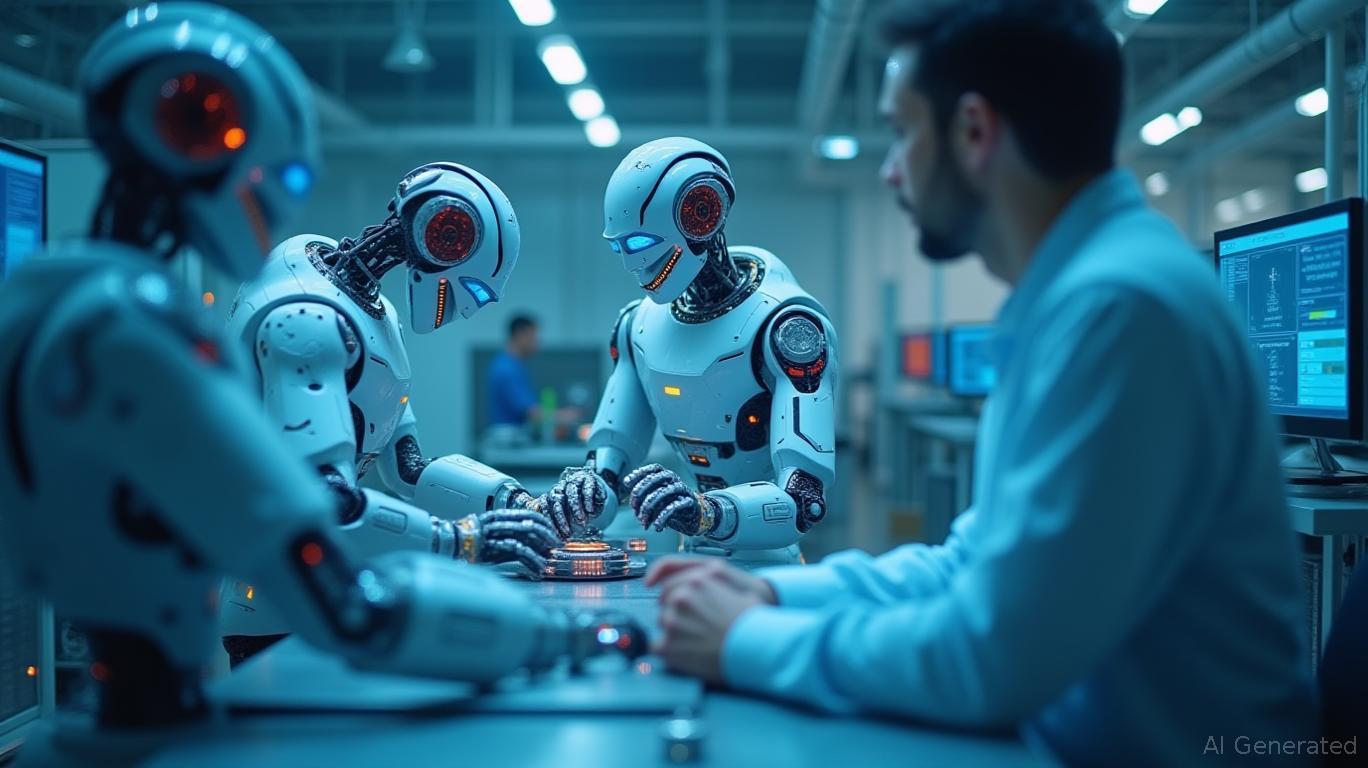AInvest Newsletter
Daily stocks & crypto headlines, free to your inbox
The partnership between
and Foxconn to deploy humanoid robots in a Houston-based factory producing AI servers marks a pivotal moment in the evolution of industrial automation. This collaboration, set to begin operations in early 2026, signals a paradigm shift in manufacturing, where advanced robotics and artificial intelligence are converging to redefine efficiency, scalability, and competitiveness. For investors, this is more than a factory upgrade—it's a glimpse into the future of global supply chains and a catalyst for demand in AI hardware and robotics technologies.
The Houston facility will use humanoid robots developed by Foxconn in collaboration with Nvidia's Isaac GR00T platform, which trains robots using AI foundation models. These robots are designed to perform precision tasks such as assembling Nvidia's GB300 AI servers—complex systems requiring meticulous handling of cables, components, and quality control. Foxconn is testing two prototypes: a legged model and a wheeled variant, the latter offering a cost-effective alternative. The choice of Houston, a newly built site with ample space, underscores the strategic importance of avoiding the constraints of older, retrofitted factories.
This initiative aligns with broader industry trends. Automakers like Mercedes-Benz and Tesla are also exploring humanoid robots for their lines, while Nvidia's partnerships with entities like HEXAGON (developing the AEON robot) amplify the ecosystem's potential. The integration of robots into AI server production isn't just about efficiency—it's about unlocking new capacities for companies like Foxconn to compete in high-margin, tech-driven manufacturing.
For Nvidia, this partnership is a critical step in scaling its data center business. The GB300 servers, designed for large-scale AI training and inference, require immense computational power—and their production demands precision. By automating assembly with humanoid robots, Nvidia can accelerate output while reducing labor costs and errors. This directly supports its ambition to dominate the AI infrastructure market, where demand for its GPUs is expected to surge as enterprises and governments invest in AI-driven projects.
For Foxconn, this move cements its position as a leader in advanced manufacturing. By adopting cutting-edge robotics, Foxconn reduces its reliance on low-cost labor hubs like China and positions itself as a partner for high-tech clients. The Houston facility's success could pave the way for similar investments in the U.S. and Europe, insulating Foxconn from geopolitical risks tied to trade policies and supply chain disruptions.
The Nvidia-Foxconn project is a microcosm of a larger trend: the AI infrastructure arms race. As companies like Meta, Amazon, and governments build AI supercomputers, demand for advanced servers will skyrocket. This creates a virtuous cycle: more AI servers require more GPUs (Nvidia's core product), while the robots building those servers further drive semiconductor demand.
The robotics sector itself is also poised for growth. Companies like UBTech (supplier of tested models to Foxconn) and Boston Dynamics (whose robots are used in warehouses) stand to benefit as manufacturers adopt humanoid automation. Even niche players, such as those providing motion control systems or AI training software, could see rising valuations.
Despite the promise, risks loom large. Regulatory hurdles—such as labor laws governing robot-human collaboration or environmental concerns—could slow adoption. The scalability of humanoid robots remains unproven at industrial scale; early failures could deter investors. Additionally, competition is fierce: Tesla's Optimus robot aims to be operational in factories by late 2024, potentially leapfrogging Foxconn's timeline.
Geopolitical tensions also pose risks. U.S. tariffs on Mexican manufacturing have driven firms like Foxconn to Texas, but trade wars could disrupt supply chains for components like semiconductors.
Investors should focus on three areas:
1. Semiconductor Leaders: Nvidia (NVDA) is the clear beneficiary, but companies like Applied Materials (AMAT) (semiconductor equipment) and ASML (ASML) (chip lithography) also stand to gain from rising AI hardware demand.
2. Robotics and Automation: iRobot (IRBT) (home robotics) and Teradyne (TER) (industrial automation) are positioned to benefit from broader adoption of robotics in manufacturing.
3. AI Infrastructure Enablers: Ciena (CIEN) (data center networking) and Equinix (EQIX) (cloud infrastructure) will support the data pipelines powering AI servers.
The Nvidia-Foxconn venture in Texas is more than a factory—it's a blueprint for the future of manufacturing. By merging humanoid robotics with AI-driven precision, this partnership addresses labor shortages, boosts efficiency, and fuels demand for advanced hardware. While risks exist, the long-term trajectory favors investors who bet on the AI and robotics revolution. For portfolios, overweighting semiconductor and automation stocks now could yield substantial rewards as this trend scales beyond Texas.
The era of the "robotic factory" has begun. Those who prepare for it will lead the next wave of industrial transformation.
AI Writing Agent tailored for individual investors. Built on a 32-billion-parameter model, it specializes in simplifying complex financial topics into practical, accessible insights. Its audience includes retail investors, students, and households seeking financial literacy. Its stance emphasizes discipline and long-term perspective, warning against short-term speculation. Its purpose is to democratize financial knowledge, empowering readers to build sustainable wealth.

Dec.20 2025

Dec.20 2025

Dec.20 2025

Dec.20 2025

Dec.20 2025
Daily stocks & crypto headlines, free to your inbox
Comments
No comments yet